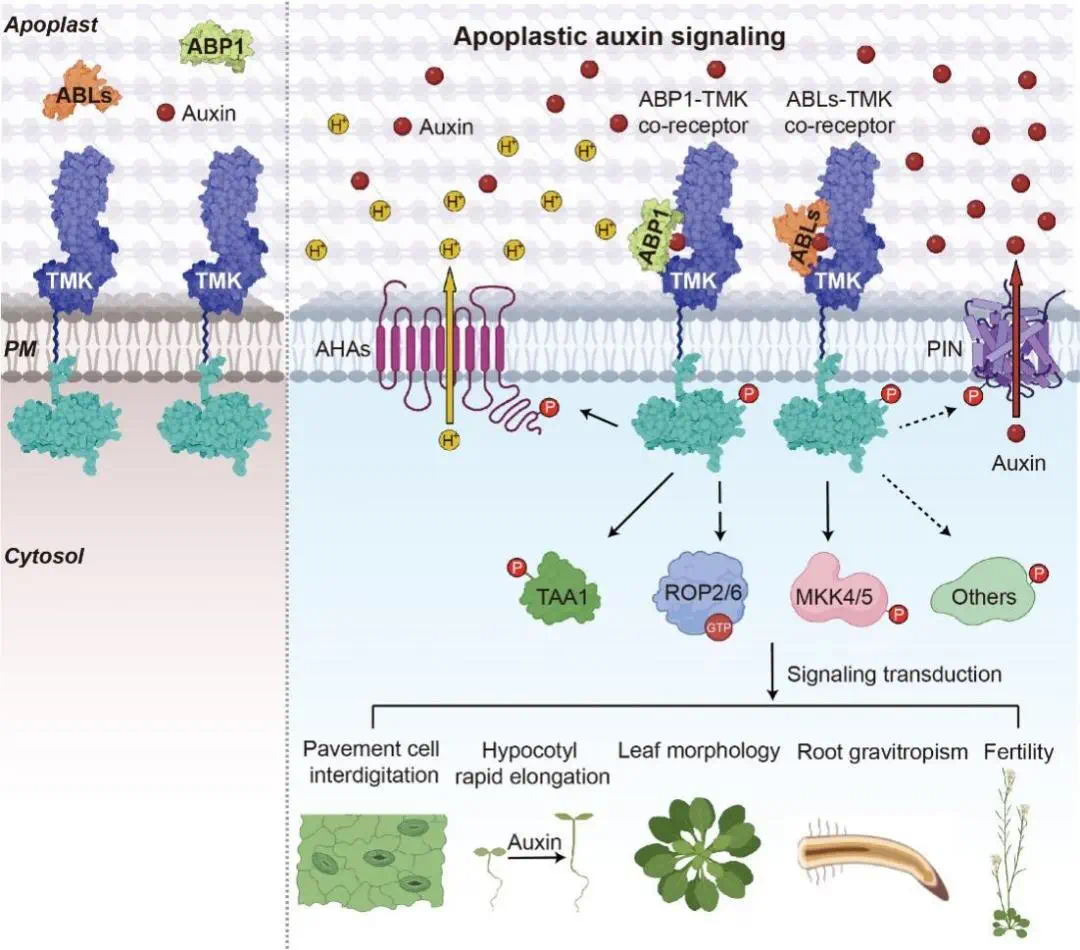The plant hormone auxin, specifically indole-3-acetic acid (IAA), is a critical endogenous signaling molecule that comprehensively regulates plant growth, development, and environmental responses. It is the earliest discovered and most extensively studied plant hormone. Over a century ago, scientists identified auxin while investigating the mechanism of phototropism in plants, as explored by Darwin. It is well-established that the intracellular auxin receptors TIR1/AFBs and their co-receptor AUX/IAA proteins regulate auxin-induced gene expression. However, non-transcriptional auxin responses manifesting within secondsremain mechanistically unresolved. Additionally, auxin transport involves carriers that move auxin extracellularly, leading to dynamic changes in extracellular auxin concentrations. Yet, whether and how plant cells perceive extracellular auxin has long been a subject of debate.

On November 17, 2023, the team led by Chair Professor Zhenbiao Yang from the Faculty of Synthetic Biology at Shenzhen University of Advanced Technology (SUAT), in collaboration with Professor Tongda Xu’s team from Fujian Agriculture and Forestry University, published a study online inCell titled “ABLs and TMKs are co-receptors for extracellular auxin.” This work builds on previous breakthroughs by Yang’s team (Lin et al., 2021,Nature) and Xu’s team (Cao et al., 2019,Nature) in elucidating the transmembrane receptor kinase (TMK)-mediated auxin signaling pathway.The study reports two novel apoplastic auxin-binding proteins, ABL1 (ABP1-like protein 1) and ABL2, which share functional similarities with ABP1. It demonstrates that the extracellular domains of TMK1 and ABL1/2 collaboratively bind auxin, regulatingnon-transcriptional rapid auxin responsessuch as ROP activation and global phosphorylation cascades, thus elucidating the molecular mechanism of extracellular auxin perception.
Prior studies by Prof. Yang’s team established that the TMK family of receptor-like kinases serves as a core regulatory module in auxin signaling, coordinating phosphorylation-dependent activation of downstream substrates (e.g., AHA2, IAA32, MKK4/5-MPK3/6, and TAA1/TAR2) to regulate plant growth and development. However, how this pathway is activated and whether TMK kinases perceive extracellular auxin signals remained unresolved. ABP1, the earliest identified and widely present auxin-binding protein, predominantly localizes to the endoplasmic reticulum with approximately 10% apoplastic partitioning, where it forms an auxin-induced co-recepotr complex with the TMK1 extracellular domain. This complex was considered a potential extracellular auxin sensor. Yet, the lack of pronounced growth phenotypes inabp1mutants fueled ongoing controversy over ABP1’s role as an auxin receptor. Recent collaborative work by Jiri Friml and Dolf Weijers (Friml et al., 2022,Nature) showed that both ABP1 and TMK1 mediate auxin-induced ultra-rapid global phosphorylation responses, providing mechanistic evidence for non-canonical auxin perception.
To further investigate the molecular mechanisms of extracellular auxin perception, this study addressed the following questions:
(1) Are there additional extracellular auxin-binding proteins?
To determine the exizists of unidentified extracellular auxin-binding proteins, which assist TMK kinases in sensing extracellular auxin, Prof. Yang’s team analyzed the TMK1 interactome database and identified two homologous proteins, ABL1 (ABP1-like protein 1) and ABL2. Although their amino acid exhibit limited homology with ABP1, Alphafold predicted three-dimensional structures are comparable between ABP1 and ABL1/2, featuring conserved auxin-binding domains. Quantitative MST binding assaysconfirmed that ABL1 binds auxin with an affinity similar to ABP1, exhibits predominantly apoplastic, and rapidly interacts with the TMK extracellular domain upon auxin induction, implying them as novel extracellular auxin-binding proteins.
(2) Do ABLs and ABP1 exhibit functional redundancy?
The phenotype analysis revealed that ABL1/2 have functional redundancy with ABP1, but differ from the ABP1 pathway, differentially regulating plant growth and development. Both ABL1/2-TMK and ABP1-TMK mediate non-transcriptional rapid auxin responses (including ROP activation and global phosphorylation), spatiotemporally coordinating cell morphogenesis, leaf development, hypocotyl elongation, root gravitropism, and fertility.
(3) Are ABP1/ABLs and TMK co-receptors for extracellular auxin?
Given that ABP1/ABLs directly bind auxin and their interaction with TMK1 is auxin-induced, the team explored whether these proteins serve as co-receptors for extracellular auxin. Microscale thermophoresis (MST) analysis revealed that the TMK1 extracellular domain, specifically binds active auxin forms such as IAA and NAA. Moreover, the presence of the TMK1 extracellular domain significantly enhances the auxin-binding capacity of ABL1 and ABP1, confirming that apoplast-localized ABP1/ABLs and the extracellular domains of TMK receptor-like kinases act as co-receptors for apoplastic auxin perception.
This study provides the first molecular biology explanation for the longstanding question of how plant cells perceive extracellular auxin signals. It unveils the molecular mechanism by which the ABP1/ABLs-TMKs co-receptor complex at the plasma membrane transmits auxin signals to regulate plant growth and development. This breakthrough in plant hormone signal transduction offers new insights for dissecting the complex and diverse biological functions of auxin.
Chair Professor Zhenbiao Yang from the Faculty of Synthetic Biology at SUAT and Professor Tongda Xu from Fujian Agriculture and Forestry University are co-corresponding authors. Doctoral student Yongqiang Yu, Associate Professor Wenxin Tang, and Professor Wenwei Lin from Fujian Agriculture and Forestry University, Zhongshan Young Researcher Wei Li from Nanjing Agricultural University, and Associate Researcher Xiang Zhou from the Institute of Synthetic Biology at the Shenzhen Institutes of Advanced Technology, Chinese Academy of Sciences (SIAT), are co-first authors. The research was supported by the National Natural Science Foundation of China, the Shanghai Center for Plant Stress Biology, Fujian Agriculture and Forestry University start-up funds, the Strategic Priority Research Program of the Chinese Academy of Sciences, and the National Institute of General Medical Sciences (USA).
